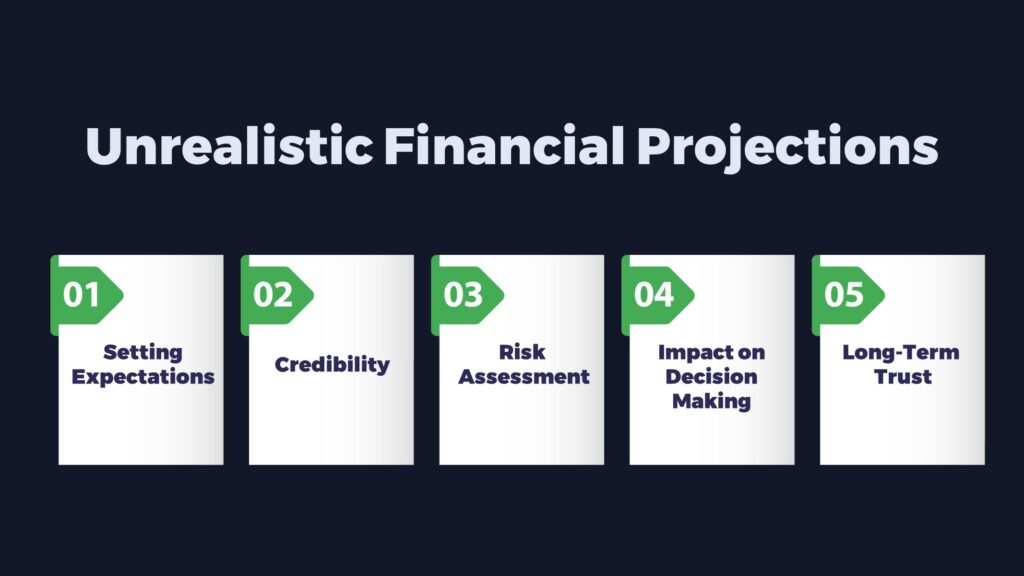Pitch Deck Blunders: Real-Life Failures That Ruined Startups
Pitch Deck Blunders can significantly impact the fate of startups. A well-crafted pitch deck is vital for securing funding, but it’s not a guaranteed ticket to success. In this article, we’ll delve into Pitch Deck Blunders and real-life failures that have sent promising startups spiraling into obscurity.
- Neglecting a Compelling Executive Summary
- Overloading with Information
- Lack of Clarity in Value Proposition
- Ignoring Market Research
- Neglecting the Problem-Solution Fit
- Poor Storytelling
- Neglecting the Team
- Unrealistic Financial Projections
- Lack of a Clear Ask
- Disregarding Competition
- Poor Design and Visuals
- Failure to Address Risks
- Neglecting the Exit Strategy
- FAQs
- Conclusion
Neglecting a Compelling Executive Summary
In the realm of pitch deck presentation, the executive summary holds a pivotal role, serving as the very first impression that investors have of your startup. This section encapsulates the essence of your business in a concise and compelling manner, acting as a teaser for what’s to come in the rest of the presentation.
Neglecting the creation of a compelling executive summary is a significant blunder that many startups make, and its consequences can be profound. Here’s a more in-depth explanation:
First Impressions Matter
The executive summary is your startup’s elevator pitch, and it’s where you need to grab your audience’s attention immediately. Neglecting this crucial component means failing to make a strong first impression, potentially causing investors to lose interest before they’ve even delved into the heart of your pitch.
Lost Opportunity
This section is your chance to hook investors, to make them curious and excited about your business. Neglecting it means squandering an opportunity to pique their interest and compel them to learn more.
Clarity and Conciseness
A compelling executive summary should be clear and concise. It should encapsulate your startup’s mission, value proposition, market opportunity, and team in a way that’s easy to understand. Neglecting this aspect might result in a vague or convoluted summary that leaves investors bewildered rather than intrigued.
Setting the Tone
The executive summary sets the tone for the entire pitch deck. If it’s uninspiring or unclear, it can cast a shadow of doubt over the rest of your presentation. On the other hand, a well-crafted summary can instill confidence and enthusiasm in your investors.
Missed Engagement
Neglecting this aspect also means missing out on a valuable opportunity for audience engagement. An effective executive summary engages the reader or listener, making them want to know more about your startup’s story.
Ready to transform your startup’s pitch deck and secure the investment you deserve? Let Easy Capraise be your guide to success! Contact us today to discover how we can help you create a winning pitch deck, sales deck, and fund deck that will captivate investors and propel your business to new heights.
Overloading with Information
Avoiding Pitch Deck Blunders means finding a balance between providing comprehensive data and overwhelming your audience with information.
Pitch decks are meant to convey key information concisely and effectively. Overloading your pitch deck with excessive data, statistics, and details can be counterproductive. Here’s a deeper understanding:
Balancing Act
Overloading with information occurs when you include too much detail, making it difficult for investors to grasp the core message of your startup. Avoiding this blunder involves carefully curating the content to include only the most relevant and impactful information.
Cognitive Load
When a pitch deck overwhelms with data, it can create a cognitive load on the audience, causing confusion and distraction. Effective pitch decks strike a balance by providing enough information to support your claims without overwhelming the audience’s cognitive capacity.
Loss of Focus
Overloading with information can lead to a loss of focus. Instead of concentrating on your startup’s value proposition and potential, investors may get bogged down in details that are better suited for follow-up discussions.
Visual Clutter
Visual elements, such as slides filled with too many charts and graphs, can contribute to visual clutter, diminishing the impact of your message. Avoiding this blunder involves presenting data in a visually digestible format.
Simplicity is Key
Simplicity is often the key to success in pitch deck design. By prioritizing clarity and conciseness, you can ensure that your message resonates with investors without overwhelming them.
Lack of Clarity in Value Proposition
Pitch Deck Blunders often stem from a failure to communicate a startup’s unique value proposition clearly.
The value proposition is the heart of your startup’s identity. Failing to articulate it clearly can lead to confusion and missed opportunities. Here’s a closer look:
Core Message
The value proposition is essentially your startup’s promise to its customers or clients. It outlines what makes your product or service unique and how it addresses a specific problem or need. Neglecting clarity in this aspect can result in investors not fully grasping what sets your startup apart from all the others out there.
Confusing Messaging
Lack of clarity in the value proposition can result in confusing messaging. If investors can’t easily understand how your startup benefits its target audience, they are less likely to invest.
Differentiation
In a crowded market, investors want to know why your startup is different and why it’s worth their money. Pitch Deck Blunders often occur when this differentiation is not made crystal clear.
Impact on Decision-Making
An unclear value proposition can lead to longer decision-making processes for investors. When they’re unsure about the value your startup offers, they may delay or decline investment.
The Importance of Simplicity
Simplicity in articulating your value proposition is crucial. Using jargon or overly complex language can hinder understanding. The value proposition should be straightforward and easily digestible.
Ignoring Market Research
A classic among Pitch Deck Blunders is overlooking thorough market research, which is essential for impressing potential investors. Market research is the foundation upon which your startup’s strategy is built. Ignoring it can lead to serious consequences. Here’s a deeper explanation:
Understanding the Landscape
Market research provides a deep understanding of the market landscape. Ignoring this aspect means that you might lack critical insights into market trends, customer preferences, and competitive forces.
Risk Assessment
Market research helps in identifying and assessing risks. By neglecting this, you may overlook potential obstacles that could hinder your startup’s growth.
Investor Confidence
Investors want to see that you’ve done your homework. They are more likely to be impressed by a pitch that demonstrates a thorough grasp of market dynamics and customer behaviors.
Validation of Opportunity
Market research can validate the opportunity you’re pursuing. It provides evidence that there’s a demand for your product or service. Without this validation, investors may doubt the viability of your startup.
Tailored Strategy
Ignoring market research can lead to a lack of a tailored strategy. A one-size-fits-all approach rarely works in business. Investors prefer startups that have a strategy specifically designed to address the unique characteristics of their target market.
Neglecting the Problem-Solution Fit
Avoiding Pitch Deck Blunders involves establishing a clear link between your product or service and a genuine market problem. The problem-solution fit is a fundamental aspect of a startup’s value proposition. Neglecting it can leave investors questioning the relevance of your offering. Here’s a more in-depth explanation:
Identifying the Pain Point
A critical part of the problem-solution fit is identifying a genuine pain point or problem in the market that your product or service can address. Neglecting this step means your startup may lack a clear purpose.
Demonstrating Relevance
Investors want to see that your product or service is relevant to the market. Failing to establish this link can result in them perceiving your startup as a solution in search of a problem.
Market Validation
The problem-solution fit is a form of market validation. It indicates that there’s a real need for what you’re offering. Ignoring this aspect can lead to skepticism among investors.
Addressing Investor Concerns
Investors often have concerns about market adoption. They want assurance that your solution will resonate with customers. Pitch Deck Blunders occur when this assurance is lacking.
Influence on Funding
The problem-solution fit directly impacts your startup’s funding potential. Investors are more likely to invest in startups that have clearly defined how they address a specific market problem.
Poor Storytelling
Storytelling is a key aspect of avoiding Pitch Deck Blunders. Failing to present a compelling narrative can render your pitch uninspiring. Storytelling is a powerful tool in pitching your startup to investors. Neglecting this aspect can lead to a dry and forgettable presentation. Here’s a more detailed explanation:
Engagement and Connection
Good storytelling engages the audience emotionally and helps them connect with your startup’s journey. Pitch Deck Blunders often occur when this emotional connection is missing.
Contextualizing the Problem
Storytelling allows you to contextualize the problem your startup solves. It helps investors understand the pain point from the perspective of your target audience.
Showcasing the Vision
Your startup’s story should also showcase your vision for the future. Investors want to know where you’re headed and why your solution is essential in that journey.
Memorability
A well-told story is memorable. It helps your pitch stand out in the minds of investors, making it more likely that they’ll recall your startup when making investment decisions.
Humanizing Your Startup
Storytelling humanizes your startup. It’s an opportunity to introduce the people behind the business, their motivations, and their commitment. Failing to do so can make your pitch seem impersonal.
Neglecting the Team
Investors invest in people as well as ideas. Pitch Deck Blunders often include failing to showcase the strength and experience of your team. Your team is a critical factor in your startup’s success. Neglecting to highlight their capabilities can lead to doubts in the minds of investors. Here’s a deeper explanation:
Team Credibility
Investors want to know that your team has the skills and experience necessary to execute your startup’s vision. Neglecting this aspect can raise questions about your team’s credibility.
Complementary Skills
An effective team often has members with complementary skills. Highlighting this can demonstrate that your startup is well-rounded and equipped to handle challenges.
Execution Capabilities
Investors are not just investing in an idea; they’re investing in your team’s ability to execute that idea. Neglecting to showcase your team’s execution capabilities can be a significant Pitch Deck Blunder.
Trust and Confidence
Your team is the embodiment of your startup. Investors need to have trust and confidence in the people driving the business forward. Neglecting to introduce your team can result in a lack of trust.
Transparency
Highlighting your team also adds an element of transparency to your pitch. It shows that you’re open about who is responsible for various aspects of the business.
Unrealistic Financial Projections

Optimism is essential, but avoiding Pitch Deck Blunders means ensuring that your financial projections are grounded in reality. Financial projections are a critical aspect of your pitch. Unrealistic projections can raise red flags among investors. Here’s a more detailed explanation:
Setting Expectations
Unrealistic financial projections can set unrealistic expectations. When your projections are too ambitious, investors may doubt your ability to achieve them.
Credibility
Investors want to see credible financial projections that are based on sound assumptions and market data. Neglecting this aspect can erode your pitch’s credibility.
Risk Assessment
Unrealistic financial projections often ignore potential risks and challenges. Investors appreciate a realistic assessment of potential hurdles and how you plan to overcome them.
Impact on Decision-Making
Unrealistic projections can affect investors’ decision-making. If they believe your projections are too good to be true, they may hesitate to invest.
Long-Term Trust
Pitch Deck Blunders related to financial projections can impact long-term trust. If your startup doesn’t meet its projections, it can lead to disappointment and loss of investor confidence.
Lack of a Clear Ask
Pitch Deck Blunders can occur when you fail to articulate what you need from investors, leaving them uncertain about their role. In a pitch, it’s crucial to be clear about what you’re asking from investors. A lack of a clear ask can lead to misunderstandings and missed opportunities. Here’s a more detailed explanation:
Investor Expectations
Investors want to know how they can contribute to your startup’s success. A clear ask helps set expectations and outlines their role in supporting your venture.
Transparency
A clear ask adds transparency to your pitch. It shows that you’ve thought about how investors can be involved and what they’ll get in return.
Decision Clarity
Without a clear ask, investors may be unsure about the decision they need to make. It can lead to delays or hesitation in making investment commitments.
Relationship Building
A clear ask also facilitates relationship building. It establishes a foundation for collaboration and ongoing communication with investors.
Demonstrating Purpose
Pitch Deck Blunders often occur when there’s no clear ask because it may give the impression that you’re not entirely sure about your startup’s purpose or how you’ll use the investment.
Disregarding Competition
Pitch Deck Blunders often involve ignoring or downplaying your competition, a mistake that can lead to doubts among investors. Acknowledging and addressing competition is essential in a pitch. Ignoring it can be a significant blunder. Here’s a deeper understanding:
Market Realities: Investors know that every market has competition. Disregarding this fact can make your pitch seem unrealistic or uninformed.
Competitive Advantage
Investors want to know how your startup will compete and thrive in a competitive landscape. Neglecting to address this raises concerns about your business strategy.
Market Positioning
Pitch Deck Blunders often occur when you don’t position your startup in relation to competitors. Investors need to understand where you fit in the market.
Risk Assessment
Ignoring competition can indicate a lack of thorough market research and risk assessment. Investors appreciate startups that are aware of potential challenges.
Market Share
Investors may want to know your strategy for gaining market share or distinguishing yourself from competitors. Neglecting competition means missing an opportunity to address this.
Poor Design and Visuals
Aesthetics matter when avoiding Pitch Deck Blunders. A cluttered or poorly designed pitch deck can detract from your message. The visual presentation of your pitch deck plays a significant role in how it’s received. Poor design and visuals can undermine the impact of your message. Here’s a more detailed explanation:
First Impressions: Your pitch deck’s design is often the first thing investors see. A poorly designed deck can create a negative first impression and affect their perception of your startup.
Visual Clarity
Effective design ensures visual clarity. A cluttered or confusing layout can make it difficult for investors to understand your message.
Professionalism
A well-designed pitch deck conveys professionalism. It shows that you’ve invested time and effort in presenting your startup in the best possible light.
Visual Storytelling
Visual elements can enhance storytelling. Neglecting design means missing the opportunity to use visuals to reinforce your narrative.
Brand Consistency
Pitch Deck Blunders can occur when design elements are inconsistent with your brand. Consistency in design reinforces brand identity and messaging.
Failure to Address Risks
Every startup has risks, and avoiding Pitch Deck Blunders involves acknowledging and addressing them transparently. Risks are an inherent part of entrepreneurship, and investors understand this. Failing to address risks can raise concerns. Here’s a more detailed explanation:
Risk Identification
A crucial aspect of addressing risks is identifying them. Ignoring this step can indicate a lack of thorough risk assessment.
Transparency
Investors appreciate transparency regarding potential challenges. A failure to address risks may lead to questions about your startup’s honesty.
Mitigation Strategies
Investors want to know that you have plans in place to mitigate or manage risks. Pitch Deck Blunders often occur when these strategies are not communicated.
Risk Impact
Failing to address risks can leave investors wondering about the potential impact on your startup’s success. Investors prefer startups that have considered the worst-case scenarios.
Confidence Building
Addressing risks is an opportunity to build confidence. It shows that you’ve thought about potential obstacles and have strategies in place to navigate them.
Neglecting the Exit Strategy
Avoiding Pitch Deck Blunders means outlining a clear exit strategy, demonstrating how investors will realize a return on their investment. Investors want to know how and when they can expect to see returns on their investment. Neglecting to provide an exit strategy can create uncertainty. Here’s a more detailed explanation:
Investor ROI
An exit strategy directly impacts investor return on investment (ROI). Neglecting this aspect means you’re not addressing one of the primary concerns of investors.
Understanding the Timeline
Investors often have specific timelines for their investments. An exit strategy clarifies how and when they can expect to see returns, helping them align their expectations.
Lack of Clarity
Pitch Deck Blunders often occur when there’s a lack of clarity about how investors will eventually exit their investment. This can lead to hesitation or skepticism.
FAQs
What should I include in an executive summary to avoid Pitch Deck Blunders?
An executive summary should provide a concise overview of your startup, including its mission, value proposition, market opportunity, and team.
How do I create realistic financial projections and avoid Pitch Deck Blunders?
To avoid Pitch Deck Blunders, create realistic financial projections based on thorough market research, industry benchmarks, and a detailed understanding of your business model.
Why is storytelling important in a pitch deck and for avoiding Pitch Deck Blunders?
Storytelling helps avoid Pitch Deck Blunders by creating an emotional connection with investors and making your pitch more memorable.
Conclusion
Pitch Deck Blunders can be costly, but by learning from these real-life failures, you can improve your chances of success in the competitive startup landscape. A well-crafted pitch deck is your gateway to attracting investors who believe in your vision.
Contact us
Good to have you here! If you have any queries, please leave your message. Our team will reach out soon:)
.








